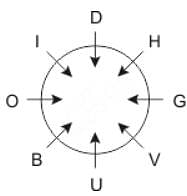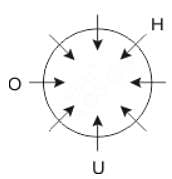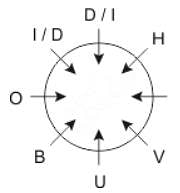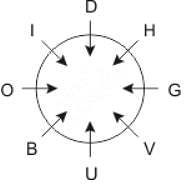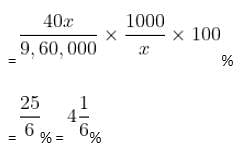SSC GD Constable Mock Test - 9 - SSC MTS / SSC GD MCQ
30 Questions MCQ Test SSC GD Constable Mock Test Series 2024 - SSC GD Constable Mock Test - 9
Ritu goes 30 km towards North from a fixed point, then after turning to her right she goes 15 km. After this she goes 30 km after turning to her right. How far and in what
direction is she from her starting point?
direction is she from her starting point?
Directions to Solve
In each of the following questions two statements are given and these statements are followed by two conclusions numbered (1) and (2). You have to take the given two statements to be true even if they seem to be at variance from commonly known facts. Read the conclusions and then decide which of the given conclusions logically follows from the two given statements, disregarding commonly known facts.
Question -
Statements: All buildings are chalks. No chalk is toffee.
Conclusions:
- No building is toffee
- All chalks are buildings.
| 1 Crore+ students have signed up on EduRev. Have you? Download the App |
Directions: Study the following information carefully and answer the question given below.
Eight people O, H, U, V, I, D, B and G are sitting around a circular table facing the centre.
O is sitting second to the left of U and third to right of H. D and I are immediate neighbors of each other and one of them is an immediate neighbor of O. V is sitting second to the right of B. G is sitting second to the left of D.
Q. What is the position of U with respect to B?
60 litres of a 75% solution of wine is taken into a laboratory. 4 litres of the solution is flushed and 4 litres of water is added to compensate the loss. Then 5 litres of the solution is flushed again and 5 litres of water is added. Again 6 litres of the solution is flushed and 6 litres of water is added. The final concentration of wine in the solution is
A vessel contains a mixture of two liquids A and B in the ratio of 4:1. When 10 litres of the mixture is replaced with liquid B, the ratio becomes 2:3. How many litres of liquid A was present in the jar initially?
Two equal sums were borrowed at 8% simple interest per annum for 2 years and 3 years respectively. The difference in the interest was Rs. 56. The sum borrowed were
In what time will Rs. 500 give Rs. 50 as interest at the rate of 5% per annum simple interest?
If the places of last two-digits of a three digit number are interchanged, a new number greater than the original number by 36 is obtained. What is the difference between the last two digits of that number?
40% of the women are above 30 years of age and 80 percent of the women are less than or equal to 50 years of age. 20 percent of all women play basketball.If 30 percent of the women above the age of 50 plays basketball, what percent of players are less than or equal to 50 years?
Of all the students in a certain dormitory, half are first-year students and the rest are second-year students. If 4/5 of the first-year students have not declared a major and the fraction of second-year students who have declared a major is 3 times the fraction of the first-year students who have declared a major, then what fraction of all the students in the dormitory are second-year students who have not declared a major?
Directions: In a paper of CAT there are 3 sections, each contains 25 questions and each question carries 4 marks. Wrong answer carries 1 mark negative. There is no negative or positive marking for not attempted question. A student attempted the questions from section A, B and C in the ratio 6 : 5 : 4. The number of correct answers are in the ratio 4 : 3 : 2, respectively. The student got 96 marks in section A.
Q. How many marks will the student get in section C?
An unscrupulous vendor professes to sell guavas at cost price but she uses a weight of 960 gm instead of a 1 kg weight. Her gain percent is
A tent is in the form of a right circular cylinder surmounted by a cone. The diameter of the cylinder is 24 m. The height of the cylindrical portion is 11 m, while the vertex of the cone is 16 m above the ground. What is the area of the curved surface for the conical portion?

Which one of the following is a viral disease in man?
Which of the following states has international borders with three countries?
Consider the following statements with reference to food fortification in India:
1. Fortified rice is distributed through the Public Distribution System in some states.
2. Milk and edible oil require mandatory food fortification.
3. Andhra Pradesh leads in Food Fortification Index.
Which of the statements given above is/are correct?
What was special about Lakshya Sen's victory in the Canada Open?
Who became the first male archer to win a gold medal in the recurve event at the World Youth Archery Championships in 2023?
Who has been appointed as the new chairperson of the International Financial Services Centres Authority (IFSC
Each species has its special place or habitat. An (31)____ bird watcher can look at (32)____forest, meadow, lake , swamp or field and (33)____ almost exactly what birds he (34)____find there (35)____birds are found all over the world; others (36)____ themselves to certain areas. Still (37)____migrate from one country to another in (38)____in search of warmth and (39)____, and then return in spring,(40)____the season is more favourable.
Q. Find the word most appropriate for Blank No. 32
The beginning of the show always brought in lots of money, yet the average singerended the show with a decrease in what their tip may be.
Directions: Read the passage and answer the questions that follow:
Paragraph 1: The government has announced a list of ‘Institutes of Eminence’ (IoE) among India’s institutions of higher education. This was awaited for the simple reason that finding a place on it would save an educational institution from the clutches of a dreaded regulator. Regulators are meant to ensure that we have a socially desirable outcome, but in the case of higher education in India the opposite seems to have been the case. The University Grants Commission (UGC) has over half a century micro-managed this space to an unimaginable level of silliness. The result has been publicly-funded universities that are cavernous wastes, shattering the aspirations of our youth and producing low-level ‘knowledge’. Evidence of the role of India’s higher-education regulator may be seen in the feature that the few instances when this is not the case the institutions have enjoyed privilege that leaves them protected from its depredations.
Paragraph 2: The latest offering is in the form of a proposed Higher Education Commission of India (HECI). The intention is to leave the HECI to focus on quality while leaving funding of public institutions to the Ministry of Human Resource Development (MHRD). Even as we observe the progress of the HECI and wonder if it is going to be any more than old wine in a new bottle, we already have an inkling of what could go wrong. This springs from the government’s announcement of a list of IoEs. The government has chosen three public and three private institutions for this status. The public institutions are the Indian Institute of Science, Bengaluru, and the Indian Institutes of Technology at Delhi and Mumbai. The private ones are the Birla Institute of Technology and Science Pilani, the JIO Institute and the Manipal Academy of Higher Education. This list suffers from a serious lack of credibility. Where in it are the universities of India? We understand that the government’s aim is to rectify the low presence of Indian institutions in the global rankings of universities.
Paragraph 3: While the early European universities may have started as academies of the arts they were soon to have medicine and astronomy as areas that they pursued with vigour. Somewhere along the line we seem to have lost this breadth and come to revel in a landscape dominated by engineering schools. These engineering schools, notably the IITs, have done us proud but cannot be equated with the great universities of the world for the simple reason that they are focussed on a narrow domain. Also, if the idea behind IoEs is that they will be left alone and given enhanced financial support, it must be acknowledged that until very recently the IITs have not been meddled with neither have they been starved of resources. The IISc is of course broader than the IITs but does not embrace the social sciences and the humanities, the presence of which would be considered necessary for a university.
Paragraph 4 : If a list of eminent institutions in the country is at all needed, the absence of the Jawaharlal Nehru University (JNU) from the first list of IoEs is striking. Its faculty has brought many of the world’s leading ideas to Indian students and in at least area came close to building a new school of thought, however controversial. It is not as if similar efforts in the social sciences have not occurred elsewhere in India but JNU has perhaps sustained its reputation as a university for longer. It already had schools of Computer Science and the Life Sciences over four decades ago when these were fledgling disciplines giving it a certain breadth early on.
Paragraph 5 : Even as we may wonder at the exclusion of JNU from the list of IoEs released by the government one might wonder at how the private institutions that are on it made the cut. While BITS Pilani may have made a significant contribution to the country at a time when it desperately needed engineers, but is yet not what may be considered a university, the presence of the two others on the list leave one nonplussed. One of them, we are told, has been conferred the status on grounds of its promise, a dubious position to take as this institute has little to show except for the financial heft that will surely undergird it. The other is known largely for its association with the practice of charging capitation fees for education.
Q. Which of the following may be inferred from paragraph 3?
I. Universities should embody knowledge across a wide range of disciplines.
II. There is an emphasis on a depth of knowledge across a broad horizon in Indian Universities today.
III. In India, a lot of focus is given to Institutions which are focused on only few areas.
Directions: Read the passage and answer the questions that follow:
Paragraph 1 : The government has announced a list of ‘Institutes of Eminence’ (IoE) among India’s institutions of higher education. This was awaited for the simple reason that finding a place on it would save an educational institution from the clutches of a dreaded regulator. Regulators are meant to ensure that we have a socially desirable outcome, but in the case of higher education in India the opposite seems to have been the case. The University Grants Commission (UGC) has over half a century micro-managed this space to an unimaginable level of silliness. The result has been publicly-funded universities that are cavernous wastes, shattering the aspirations of our youth and producing low-level ‘knowledge’. Evidence of the role of India’s higher-education regulator may be seen in the feature that the few instances when this is not the case the institutions have enjoyed privilege that leaves them protected from its depredations.
Paragraph 2 : The latest offering is in the form of a proposed Higher Education Commission of India (HECI). The intention is to leave the HECI to focus on quality while leaving funding of public institutions to the Ministry of Human Resource Development (MHRD). Even as we observe the progress of the HECI and wonder if it is going to be any more than old wine in a new bottle, we already have an inkling of what could go wrong. This springs from the government’s announcement of a list of IoEs. The government has chosen three public and three private institutions for this status. The public institutions are the Indian Institute of Science, Bengaluru, and the Indian Institutes of Technology at Delhi and Mumbai. The private ones are the Birla Institute of Technology and Science Pilani, the JIO Institute and the Manipal Academy of Higher Education. This list suffers from a serious lack of credibility. Where in it are the universities of India? We understand that the government’s aim is to rectify the low presence of Indian institutions in the global rankings of universities.
Paragraph 3 : While the early European universities may have started as academies of the arts they were soon to have medicine and astronomy as areas that they pursued with vigour. Somewhere along the line we seem to have lost this breadth and come to revel in a landscape dominated by engineering schools. These engineering schools, notably the IITs, have done us proud but cannot be equated with the great universities of the world for the simple reason that they are focussed on a narrow domain. Also, if the idea behind IoEs is that they will be left alone and given enhanced financial support, it must be acknowledged that until very recently the IITs have not been meddled with neither have they been starved of resources. The IISc is of course broader than the IITs but does not embrace the social sciences and the humanities, the presence of which would be considered necessary for a university.
Paragraph 4 : If a list of eminent institutions in the country is at all needed, the absence of the Jawaharlal Nehru University (JNU) from the first list of IoEs is striking. Its faculty has brought many of the world’s leading ideas to Indian students and in at least area came close to building a new school of thought, however controversial. It is not as if similar efforts in the social sciences have not occurred elsewhere in India but JNU has perhaps sustained its reputation as a university for longer. It already had schools of Computer Science and the Life Sciences over four decades ago when these were fledgling disciplines giving it a certain breadth early on.
Paragraph 5 : Even as we may wonder at the exclusion of JNU from the list of IoEs released by the government one might wonder at how the private institutions that are on it made the cut. While BITS Pilani may have made a significant contribution to the country at a time when it desperately needed engineers, but is yet not what may be considered a university, the presence of the two others on the list leave one nonplussed. One of them, we are told, has been conferred the status on grounds of its promise, a dubious position to take as this institute has little to show except for the financial heft that will surely undergird it. The other is known largely for its association with the practice of charging capitation fees for education.
Q. What could be a/some result/s of the function of funding of public institutions being left to the Ministry of Human Resource Development instead of HECI?
I. The government may use its discretion to reward institutions according to its ideological predilections.
II. The Institutions may be forced to comply with even some dubious rules setup by the government.
III. The government can be made accountable for attaining excellence in education.
Directions: Read the passage and answer the questions that follow:
Paragraph 1 : The government has announced a list of ‘Institutes of Eminence’ (IoE) among India’s institutions of higher education. This was awaited for the simple reason that finding a place on it would save an educational institution from the clutches of a dreaded regulator. Regulators are meant to ensure that we have a socially desirable outcome, but in the case of higher education in India the opposite seems to have been the case. The University Grants Commission (UGC) has over half a century micro-managed this space to an unimaginable level of silliness. The result has been publicly-funded universities that are cavernous wastes, shattering the aspirations of our youth and producing low-level ‘knowledge’. Evidence of the role of India’s higher-education regulator may be seen in the feature that the few instances when this is not the case the institutions have enjoyed privilege that leaves them protected from its depredations.
Paragraph 2 : The latest offering is in the form of a proposed Higher Education Commission of India (HECI). The intention is to leave the HECI to focus on quality while leaving funding of public institutions to the Ministry of Human Resource Development (MHRD). Even as we observe the progress of the HECI and wonder if it is going to be any more than old wine in a new bottle, we already have an inkling of what could go wrong. This springs from the government’s announcement of a list of IoEs. The government has chosen three public and three private institutions for this status. The public institutions are the Indian Institute of Science, Bengaluru, and the Indian Institutes of Technology at Delhi and Mumbai. The private ones are the Birla Institute of Technology and Science Pilani, the JIO Institute and the Manipal Academy of Higher Education. This list suffers from a serious lack of credibility. Where in it are the universities of India? We understand that the government’s aim is to rectify the low presence of Indian institutions in the global rankings of universities.
Paragraph 3 : While the early European universities may have started as academies of the arts they were soon to have medicine and astronomy as areas that they pursued with vigour. Somewhere along the line we seem to have lost this breadth and come to revel in a landscape dominated by engineering schools. These engineering schools, notably the IITs, have done us proud but cannot be equated with the great universities of the world for the simple reason that they are focussed on a narrow domain. Also, if the idea behind IoEs is that they will be left alone and given enhanced financial support, it must be acknowledged that until very recently the IITs have not been meddled with neither have they been starved of resources. The IISc is of course broader than the IITs but does not embrace the social sciences and the humanities, the presence of which would be considered necessary for a university.
Paragraph 4 : If a list of eminent institutions in the country is at all needed, the absence of the Jawaharlal Nehru University (JNU) from the first list of IoEs is striking. Its faculty has brought many of the world’s leading ideas to Indian students and in at least area came close to building a new school of thought, however controversial. It is not as if similar efforts in the social sciences have not occurred elsewhere in India but JNU has perhaps sustained its reputation as a university for longer. It already had schools of Computer Science and the Life Sciences over four decades ago when these were fledgling disciplines giving it a certain breadth early on.
Paragraph 5 : Even as we may wonder at the exclusion of JNU from the list of IoEs released by the government one might wonder at how the private institutions that are on it made the cut. While BITS Pilani may have made a significant contribution to the country at a time when it desperately needed engineers, but is yet not what may be considered a university, the presence of the two others on the list leave one nonplussed. One of them, we are told, has been conferred the status on grounds of its promise, a dubious position to take as this institute has little to show except for the financial heft that will surely undergird it. The other is known largely for its association with the practice of charging capitation fees for education.
Q. Which of the following best describes the tone of the author in paragraph 1?
Directions: Out of the given alternatives, choose the one which can be substituted for the given words/sentence.
A disease that spreads over a large area:
|
82 docs|10 tests
|
|
82 docs|10 tests
|



